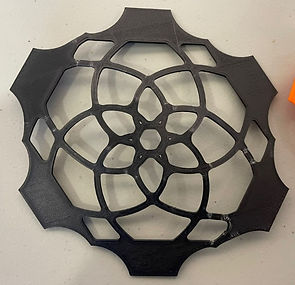
Hexagonal Bio-Inspired Grid

Objective
Each team was given a hexagonal frame and tasked with filling that frame with a structure that ensured maximum tensile strength when tested along any of the 3 primary horizontal axes, maximum strength and deformation withstood under a transverse compressive load, and minimal overall material use.
Skills, Software, and Applied Knowledge
- SolidWorks
- Teamwork
- Technical reports
- Research
- Finite element analysis
My Contribution
Throughout this project, I acted as a mediator and coordinator for my other two teammates. Additional responsibilities included researching potential sources of biological inspiration, creating design alternatives in SolidWorks, and writing and presenting the final deliverable.
Process
Problem Description
The biologically inspired hexagonal grid design was created to be stronger and more durable than the grid patterns currently being used under roadways. The main goals were to achieve high force resistance of the structure in tension and bending across the lattice element.
Inspiration and Adaptation
My team’s design inspiration was taken from the nautilus shell. According to one study, nacre, the interior material of a nautilus shell, is the toughest material nature has to offer. The overall profile of the shell replicates a logarithmic spiral.

Two general profiles were devised based on this spiral: a symmetrical one that uses a larger radius and a more condensed logarithmic spiral with ribbing.

Finite Element Analysis
Each design was subjected to quasi-static simulation in compressive and tensile loading conditions for a total of eight simulation studies. The goal of the FEA studies was to eliminate stress concentrations by iteratively editing the dimensions and then to pick the best design by studying the peak stresses under each loading condition. Design 2 was chosen due to its low mass and low peak stresses relative to the other designs.


For the final competition, two tensile samples and one compression sample were 3D printed and their performance was judged with reference to the rest of the class.



Test Sample | Yield Strength (pounds-force) | Mass (grams) |
|---|---|---|
Compression Sample | 117 | 8.36 |
Best Tensile Sample | 96.2 | 14.78 |
Based on an equation derived to calculate the yield strength versus the mass of the part, my team came in first place for all the categories (total score, tensile score, and bending score).



